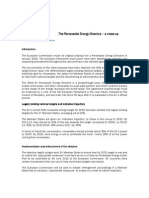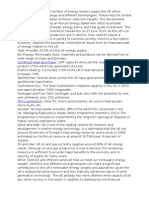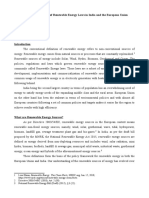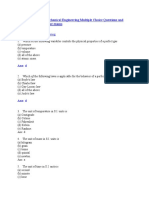Energy For Romania From Renewable Resources: Studies in Business and Economics
Energy For Romania From Renewable Resources: Studies in Business and Economics
Uploaded by
Dinu CatalinaCopyright:
Available Formats
Energy For Romania From Renewable Resources: Studies in Business and Economics
Energy For Romania From Renewable Resources: Studies in Business and Economics
Uploaded by
Dinu CatalinaOriginal Title
Copyright
Available Formats
Share this document
Did you find this document useful?
Is this content inappropriate?
Copyright:
Available Formats
Energy For Romania From Renewable Resources: Studies in Business and Economics
Energy For Romania From Renewable Resources: Studies in Business and Economics
Uploaded by
Dinu CatalinaCopyright:
Available Formats
Studies in Business and Economics
ENERGY FOR ROMANIA FROM RENEWABLE RESOURCES
LUCIAN Paul Lucian Blaga University of Sibiu, Romania
Abstract: The European Union admits the fact that energy is essential, for the development of the European economy, but that it also constitutes a challenge, due to the impact on climate change. In Romania, as well as in all the countries of the European Union, which have chosen to promote renewable energy, governments have come up with support frameworks for investors in this field. In Romanias case, the option for green schemes and compulsory quotas was selected, meaning that each energy producer, which produces renewable energy, receives a number of green certificates for each MW produced, depending on the technology it uses. The price of such a green certificate varies between 27 55 Euros. The statistics of the European Energy th Association show that Romania is ranked 7 among E.U. countries with investments in wind parks. Specialists mention that solar energy is much more efficient, because solar parks can be spread all over the country. Through the hydro-energetic potential of our country, hydro-energy can ensure national energetic security. In order to attract foreign investors into projects, for energy from renewable resources one requires new transport lines, tuning stations and equipments, for solar and wind parks. Until 2020, the Romanian state will make available for investors, at least 10 billion Euros. Producers of energy from renewable sources can sell their certificates to suppliers of energy, at a price dictated by supply and demand. Keywords: climate change, support scheme, renewable sources, green certificates, compulsory quota, wind energy, solar energy
Within the Durable Development Strategy of the European Union, revised in 2006, the energy policy is considered crucial, because it must account for climate changes at a European and Global level. At the European Council of March, 2007, the European Union assumed the following objectives: the reduction, until 2020, of CO2 emissions by 20 %, to increase renewable energy by 20 % of the total energy consumed, as well as increasing energy efficiency by 20%. The usage of renewable energy sources constitutes the major objective of the legislative framework concerning climate change and renewable energy sources, th presented by the European Commission on January 28 2008. This objective of the European Commission is much more exigent, concerning its application term, than the
- 110 - Studies in Business and Economics
Studies in Business and Economics
objective within the Durable Development Strategy of the European Union, revised in 2006. In all the documents, the European Union admits the fact that energy is essential to the development of the European economy, but also that it represents a challenge from the point of view of the impact of the energy sector on climate changes. The majority of European states depend on the import of energy resources and of the tendency of increases of energy price, on the world market. As a member state of the European Union, Romania has presented the National Action Plan to the European Union, with the mentioning of objectives concerning the percentage of renewable energy in transports, electricity, heating and cooling, but also measures which must be undertaken, to achieve these objectives. According to this plan, in 2013, 12 % of the brute internal energy consumption will be covered by renewable sources, and at the end of 2020, of all the energy that will be consumed, 24 % will be from renewable sources, and concerning the brute consumption of electric energy, the percentage of green energy to be of 38 % at the end of 2020. As a country that signed the Kyoto protocol, Romania participates at the limiting of the energy sector on climate changes, through the reduction of gas emissions with greenhouse effect with 10 % by 2013, as compared to 1989. Also, it will actively take part in converging objectives for the second period of implementation, post-2012 of the Kyoto protocol, within the Framework Convention of the United Nations. In order to sustain the assumed objectives, Romania, together with other member states of the European Union, which have chosen to promote renewable energy, comes with support schemes, for investors in the field, choosing the option of green certificates and of compulsory quotas. This means that, every energy producer, from renewable sources receives, for each MW of produced energy, a number of green certificates, and the price of such a certificate varies between 27 55 Euros. In July 2011, Romania received a favourable notice from the European Commission to support renewable energy sources. According to this notice, for each MW of energy produced from renewable energy, the investor will receive a number of green certificates, according to the technology it chose. Green certificates are a strong stimulus for international investors, willing to allocate funds towards the production of renewable energy, regardless of the weather conditions such as drought, blizzard or freezing rain. Until 2020, the Romanian state will make available 10 billion Euros for investors within this field, and international investors promise energy projects, using wind, sun, water and biomass. According to the new support scheme, for each MW of wind energy produced, two green certificates are granted. This support framework will be maintained until 2017, and from 2018 will receive only one green certificate, and the total scheme will have a total duration of 15 years, being available for units created until 2016. From the statistics of the European Wind Energy Association, it results that, in 2011, in Romania 520 MW were installed, in terms of wind parks, which represent 5%
Studies in Business and Economics - 111 -
Studies in Business and Economics
of the total new capacity, installed at the level of the 27 member states of the E.U. the same source mentions that in 2011, 9.616 MW were produced in wind parks, a value of 12,6 billion Euros, which means that in Romania, investments of 680 million Euros were made, our country being ranked 7 in a top made by the European Union and first in the region. First places belonged to Germany, Great Britain and Spain. In the last few years, wind energy had an ascension in Romania, and, at the end of 2009, 14 MW were installed, at the end of 2010 460 MW, and at the end of 2011, the total capacity of wind parks reached 982 MW. We notice that the great energy groups of Europe have made massive investments in wind parks in Romania, due to the generous aid scheme, which the Romanian state revealed, as well as due to favourable weather conditions in Dobrogea and Moldova. We appreciate that investments in wind parks are risky, precisely due to weather phenomena, which at the beginning of this year made for the elimination of wind turbines from the system, threatened by freezing rain, and which caused considerable havoc, by destroying equipment and electrical installations. The biggest winners of the support scheme for wind parks are the Czechs from CEZ, which in 2011, a favourable weather year, have cashed 39,8 million Euros, from green certificates, which account for 300 MW of installed capacity. In this context, the Czechs promise that in 2012 they will finalize 1, 1 billion Euro investments, in the biggest wind park in Romania. Also, the Italians of Enel have invested in wind parks in Dobrogea which have an installed capacity of 270 MW and which promise to continue investments in such projects. Another large energy group which have invested in important wind capacities is Energias de Portugal. After two years of wind park investment supremacy, specialists state that investments in solar energy are much more efficient, because they are not affected by drought, blizzard, freezing rain, and they will have an even larger contribution in sustaining the renewable resource energy. Investors in solar energy projects are at the beginning, and at this time 51 solar parks are being built, which account for 500 million Euros of investments, and with an installed capacity of 210,3 MW. In 2012, 14 solar parks will be operational, whose value will be of 150 million Euros, and the solar equipment producers claim that costs will be lower than those of wind energy. At the European Union level, the investments made to obtain energy from renewable sources are new investments in solar parks, with a total capacity of 21.000 MW, appreciated throughout Europe. In the state aid scheme through green certificates and compulsory quotas hydro energy is a part of this, created in units smaller than 10 MW. For new units, each MW is rewarded with 3 green certificates, and if hydro plants are refurbished they receive two green certificates, for each MW. If units have not done so, they will receive a green certificate for each 2 MW produced. Hidroelectrica is the largest energy producer in Romania, with a 30% normal quota.
- 112 - Studies in Business and Economics
Studies in Business and Economics
At IMF pressure, Hidroelectrica, together with other state companies, join the second group of companies in 2012, proposed for an I.P.O., initial public offering of 10 % of their stocks and an increase of capital. At this time, a private manager is sought after, and the company is intended for stock listing. Romania, with an acknowledged hydro energetic potential, should invest in new production units, by attracting foreign investors, to ensure energetic security. This represents a strategic direction within the energetic policy, agreed with the European Union, which comprises of maintaining national sovereignty on primary energy resources. We believe, that this form of energy, from water, is cheap and non-polluting, and ensures the energetic security of our country, if the state maintains the power of decision, regardless of the form of property and management. In order for Romania to become more attractive in the coming years for investments in renewable energy sources, further investments are required, in order to increase transport and tuning infrastructure. In order to increase transport networks, specialists estimate 500 million Euros, on a long term, an investment, which the Romanian state cannot finance by itself. In spite of the ascending evolution of renewable energy production, there is no such investment from scratch in Romania, and almost 75 % of projects are only equipments. At this time, in Romania there is no factory which could realize the equipments for the parks which produce energy from renewable sources, and all installations come from imports. As a member state of the European Union, Romania has certain obligations to fulfil concerning climate shifting and clean energy, concerning the percentage of renewable energy within the final energy consumption. In this context, the application of the green certificate system obliges producers to purchase the resulted energy, in a quota of 9-10 %, from the brute energy consumption, as reported to the amount of energy sold to consumers. The proof of fulfilling this percentage is given by the number of green certificates purchased. Energy producers from renewable resources can commercialize electricity production on a free market, where they will receive the price of green certificates, as a result of supply and demand. For energy suppliers, the purchasing of green certificates are costs, which will be included in invoices towards the population and companies, as they are the ones that finance renewable energy development in Romania. References
Strategia Nationala pentru Dezvoltare Durabila a Romaniei. Orizonturi 2013-2020-2030, Guvernul Romaniei, Ministerului Mediului si Dezvoltarii Durabile EU energy trends to 2030, Comisia Europeana, 2009 Politici europene, M. Profiroiu, I. Popescu, Editura Economica, Bucuresti 2008 Strategia de Dezvoltare Durabila a UE revizuita, Consiliul Uniunii Europene, Bruxelles, 26 iunie 2006 Strategia energetica a Romaniei 2007-2020
Studies in Business and Economics - 113 -
Copyright of Studies in Business & Economics is the property of University of Sibiu, Lucian Blaga and its content may not be copied or emailed to multiple sites or posted to a listserv without the copyright holder's express written permission. However, users may print, download, or email articles for individual use.
You might also like
- Din V 18599-8Document81 pagesDin V 18599-8Milos Petrovic100% (1)
- 1st Periodical Science 10 2019Document4 pages1st Periodical Science 10 2019Mark Kelvin DinongNo ratings yet
- Book Title: "77 Secrets To Make Every Man Adore You, Chase You, Love You, and Commit To You"Document19 pagesBook Title: "77 Secrets To Make Every Man Adore You, Chase You, Love You, and Commit To You"Dinu Catalina0% (1)
- Research: Committee On Industry, Research and Energy (ITRE)Document5 pagesResearch: Committee On Industry, Research and Energy (ITRE)GeorgiaStefanNo ratings yet
- Wind Energy ContributionDocument104 pagesWind Energy ContributionTown Obio EteteNo ratings yet
- Barobilan13 GBDocument103 pagesBarobilan13 GBCristina Anca RobuNo ratings yet
- Wind Farms Tulcea South PresentationDocument11 pagesWind Farms Tulcea South PresentationAndrei PavelNo ratings yet
- REPowerEU - A PlanDocument5 pagesREPowerEU - A PlansamNo ratings yet
- Rexel International Regulation Review June 2011Document3 pagesRexel International Regulation Review June 2011Energy 3.0No ratings yet
- EU-China Energy Magazine 2021 Summer Issue: 2021, #2From EverandEU-China Energy Magazine 2021 Summer Issue: 2021, #2No ratings yet
- EN EN: European CommissionDocument24 pagesEN EN: European Commissionandrea bottazziNo ratings yet
- Hydrogen Strategy PDFDocument24 pagesHydrogen Strategy PDFAlper KzNo ratings yet
- EN EN: European CommissionDocument14 pagesEN EN: European CommissionLim ChintakNo ratings yet
- Energy: Reducing Energy Consumption and Eliminating Energy Wastage AreDocument5 pagesEnergy: Reducing Energy Consumption and Eliminating Energy Wastage AreBogdan PopaNo ratings yet
- Romania's Funding Sources For Increasing The Share of Renewable Energy Sources and The Reduction of Greenhouse Gas EmissionsDocument12 pagesRomania's Funding Sources For Increasing The Share of Renewable Energy Sources and The Reduction of Greenhouse Gas EmissionsRaluca CalinNo ratings yet
- Energy Efficiency Policy in RomaniaDocument13 pagesEnergy Efficiency Policy in RomaniaGabriela LorenaNo ratings yet
- RES Directive SpecialDocument4 pagesRES Directive SpecialNaciye TengilimoğluNo ratings yet
- EWEA Aiming HighDocument40 pagesEWEA Aiming HighMatt MaceNo ratings yet
- Renewable Energy For Europe (Eng) / Energia Renovable para Europa (Ing) / Energia Berriztagarriak Europan (Ing)Document2 pagesRenewable Energy For Europe (Eng) / Energia Renovable para Europa (Ing) / Energia Berriztagarriak Europan (Ing)EKAI CenterNo ratings yet
- Demand Response, Decentralisation and Energy Communities - Federico PierucciDocument11 pagesDemand Response, Decentralisation and Energy Communities - Federico Pieruccipierucci93No ratings yet
- Renewable Energy Progress ReportDocument4 pagesRenewable Energy Progress ReportfanusNo ratings yet
- 3 Environment Energy PolicyDocument48 pages3 Environment Energy Policydropkick94No ratings yet
- Energy Policy in EUDocument12 pagesEnergy Policy in EUjack_portugaNo ratings yet
- Countries SortedDocument3 pagesCountries SortedKiran JilludimudiNo ratings yet
- The EURELECTRIC Energy Wisdom Programme (EWP) : Improving Energy Efficiency Reducing Carbon Emissions Meeting The 2050 ChallengesDocument68 pagesThe EURELECTRIC Energy Wisdom Programme (EWP) : Improving Energy Efficiency Reducing Carbon Emissions Meeting The 2050 ChallengesDimitrios MavromatidisNo ratings yet
- Energy Community BiHDocument23 pagesEnergy Community BiHIdaNo ratings yet
- Energy Efficiency in The Industry - Complement For Renewable Energies - Maria Holopainen VTTDocument33 pagesEnergy Efficiency in The Industry - Complement For Renewable Energies - Maria Holopainen VTTCentro de Innovación UC Anacleto AngeliniNo ratings yet
- EU China Energy Magazine 2021 Autumn Issue: 2021, #3From EverandEU China Energy Magazine 2021 Autumn Issue: 2021, #3No ratings yet
- Energy Overview 2023 enDocument8 pagesEnergy Overview 2023 enSabri GunaydinNo ratings yet
- Resources, The Power Bill ArrivesDocument5 pagesResources, The Power Bill ArrivestbwsmNo ratings yet
- EDPR Starts The Construction of Its First Solar PV Projects: Investors & Analysts' BriefingDocument1 pageEDPR Starts The Construction of Its First Solar PV Projects: Investors & Analysts' BriefingFarooq MizaNo ratings yet
- State of Nuclear Power in Europe: A ReportDocument21 pagesState of Nuclear Power in Europe: A Reportعمر نجارNo ratings yet
- Energy LawDocument8 pagesEnergy LawJaiy ChandharNo ratings yet
- EU China Energy Magazine 2022 Christmas Double Issue: 2022, #11From EverandEU China Energy Magazine 2022 Christmas Double Issue: 2022, #11No ratings yet
- EU China Energy Magazine 2021 Christmas Double Issue: 2021, #4From EverandEU China Energy Magazine 2021 Christmas Double Issue: 2021, #4No ratings yet
- EU Local: Energy ActionDocument32 pagesEU Local: Energy ActionTudor SorbanNo ratings yet
- Carpathians Session4 4Document25 pagesCarpathians Session4 4cata844No ratings yet
- Renovation WaveDocument27 pagesRenovation Wavemano.handmade.alNo ratings yet
- Energies: Italian Biogas Plants: Trend, Subsidies, Cost, Biogas Composition and Engine EmissionsDocument31 pagesEnergies: Italian Biogas Plants: Trend, Subsidies, Cost, Biogas Composition and Engine EmissionsHuy ĐoànNo ratings yet
- Figure 1.1 Primary Energy Consumption in PolandDocument4 pagesFigure 1.1 Primary Energy Consumption in PolandSri NivasNo ratings yet
- A Comparative Study of Renewable Energy Laws in India and The European UnionDocument4 pagesA Comparative Study of Renewable Energy Laws in India and The European UnionKumar SouravNo ratings yet
- RAPORT CE Dec 2019 - Renovarea Cladirilor in UEDocument89 pagesRAPORT CE Dec 2019 - Renovarea Cladirilor in UETroi LauraNo ratings yet
- Building PhysicsDocument33 pagesBuilding Physicsothmani rafaaNo ratings yet
- Commission Communication 2013-762 - Implementing The Energy Efficiency Directive - Commission Guidance (En)Document9 pagesCommission Communication 2013-762 - Implementing The Energy Efficiency Directive - Commission Guidance (En)iurii socolNo ratings yet
- Economic Aspects of The Energy Efficiency Projects in Buildings in EU Countries Compared To Southeast European CountriesDocument12 pagesEconomic Aspects of The Energy Efficiency Projects in Buildings in EU Countries Compared To Southeast European CountriesDubravkaNo ratings yet
- Energy Legislation: Primary Legislation in The Energy Field Also IncludesDocument5 pagesEnergy Legislation: Primary Legislation in The Energy Field Also IncludesFrancesco SangregorioNo ratings yet
- 2014 Energy Efficiency CommunicationDocument27 pages2014 Energy Efficiency CommunicationkktayNo ratings yet
- Gas Pressure RegulationDocument17 pagesGas Pressure RegulationOmar MasoodNo ratings yet
- EN EN: European CommissionDocument21 pagesEN EN: European CommissionJoni BobiNo ratings yet
- Energy: Sustainable, Secure and Affordable Energy For EuropeansDocument16 pagesEnergy: Sustainable, Secure and Affordable Energy For Europeansfionarml4419No ratings yet
- Romanian LTS EPG ReportDocument44 pagesRomanian LTS EPG Reportnovac valerianNo ratings yet
- 2009 Eeap Background Document PDFDocument8 pages2009 Eeap Background Document PDFIgor NeagaNo ratings yet
- Renewable Energy Romania Report and Opportunities in RomaniaDocument10 pagesRenewable Energy Romania Report and Opportunities in RomaniaAlly CumvreaueuNo ratings yet
- Cartea Alba EnglishDocument37 pagesCartea Alba EnglishilieoniciucNo ratings yet
- Business Leaders Letter On Energy UnionDocument1 pageBusiness Leaders Letter On Energy UnionclimatehomescribdNo ratings yet
- Energy Efficiency Directive Citizen Summary en PDFDocument1 pageEnergy Efficiency Directive Citizen Summary en PDFIgor NeagaNo ratings yet
- 2011 06 22 Lithuanian Energy Strategy Government Approved Ver FINALDocument54 pages2011 06 22 Lithuanian Energy Strategy Government Approved Ver FINALMantas PuidokasNo ratings yet
- EN EN: Commission of The European CommunitiesDocument20 pagesEN EN: Commission of The European CommunitiesosemeduakNo ratings yet
- Memo For Road Map of Renewable EnergyDocument4 pagesMemo For Road Map of Renewable EnergySaleh Al-TamimiNo ratings yet
- WindEurope Position Paper Non Price Criteria in AuctionsDocument13 pagesWindEurope Position Paper Non Price Criteria in AuctionsGerard PoncinNo ratings yet
- Wind Power: A Victim of Policy and Politics?Document75 pagesWind Power: A Victim of Policy and Politics?IFRINo ratings yet
- The European Union's Energy Security ChallengesDocument20 pagesThe European Union's Energy Security ChallengesAlexandru TomaNo ratings yet
- REPowerEU Joint European Action For More Affordable Secure and Sustainable EnergyDocument3 pagesREPowerEU Joint European Action For More Affordable Secure and Sustainable Energyminecrafthaters213No ratings yet
- Brussels, 15.5.2001 COM (2001) 264 Final: Commission of The European CommunitiesDocument17 pagesBrussels, 15.5.2001 COM (2001) 264 Final: Commission of The European CommunitiesDinu CatalinaNo ratings yet
- Prototype Global Sustainable Development ReportDocument165 pagesPrototype Global Sustainable Development Reporta10family10No ratings yet
- Surrendering (Surrender #1) by Ahren Sanders PDFDocument283 pagesSurrendering (Surrender #1) by Ahren Sanders PDFDinu Catalina100% (2)
- Surviving (Surrender #2) by Ahren Sanders PDFDocument281 pagesSurviving (Surrender #2) by Ahren Sanders PDFDinu Catalina80% (5)
- Surrendering (Surrender #1) by Ahren Sanders PDFDocument283 pagesSurrendering (Surrender #1) by Ahren Sanders PDFDinu Catalina100% (2)
- Flood Modeling Prediction and Mitigation PDFDocument431 pagesFlood Modeling Prediction and Mitigation PDFgerardo hernandezNo ratings yet
- Compatible Inverter: Item Data Note Uhome-Nca 6.8Kwh/Lv Uhome-Lfp 5.8Kwh/LvDocument1 pageCompatible Inverter: Item Data Note Uhome-Nca 6.8Kwh/Lv Uhome-Lfp 5.8Kwh/LvbayuNo ratings yet
- General Chemistry 1 Week 1 and 2 Quarter 1Document35 pagesGeneral Chemistry 1 Week 1 and 2 Quarter 1Katherine LucasanNo ratings yet
- Course Objective QuestionDocument243 pagesCourse Objective Questionahmish kabbaxeNo ratings yet
- General Education Final CoachingDocument135 pagesGeneral Education Final CoachingChristopher CelisNo ratings yet
- Coal Power Plant Heat Rate and EfficientDocument2 pagesCoal Power Plant Heat Rate and EfficientAnonymous W9VINoTzaNo ratings yet
- 1 EnergyDocument34 pages1 EnergyDragan TadicNo ratings yet
- Bomb CalorimeterDocument5 pagesBomb CalorimeterAbood AtiyatNo ratings yet
- AS Trial - 2004 Sep - P1Document14 pagesAS Trial - 2004 Sep - P1Syafiq ShazwanNo ratings yet
- Water Hammer Analysis: Sample ProblemsDocument15 pagesWater Hammer Analysis: Sample ProblemsZedrickTrinidad67% (3)
- Flashcards - Topic 2.2 Thermal Properties - CAIE Physics IGCSEDocument45 pagesFlashcards - Topic 2.2 Thermal Properties - CAIE Physics IGCSESaurabh.DeoNo ratings yet
- PH Ysicsguide: Problems and Solutions in Ideal Bose SystemsDocument26 pagesPH Ysicsguide: Problems and Solutions in Ideal Bose SystemsSubhradip Bhowmik100% (1)
- Unit 1: General Principles: ObjectivesDocument21 pagesUnit 1: General Principles: ObjectivesHaianh PhamNo ratings yet
- Sex Determination, Evoloution and Heridity.Document21 pagesSex Determination, Evoloution and Heridity.CP GiriNo ratings yet
- Manocha 2013Document10 pagesManocha 2013Guido ObandoNo ratings yet
- Ad For AdmDocument365 pagesAd For AdmAshmeet PradhanNo ratings yet
- The Impact of Environmental Pollution On HumanDocument6 pagesThe Impact of Environmental Pollution On HumanErdi 'Day' SidhartaNo ratings yet
- 1 Re Entry of Space VehicleDocument23 pages1 Re Entry of Space Vehiclegirithik14No ratings yet
- Bryan Steam - BrochureDocument8 pagesBryan Steam - BrochureFrancisco Hevia FariaNo ratings yet
- Effect of Bagasse Ash Filled Epoxy Composites Reinforced With Hybrid Plant Fibres ForDocument20 pagesEffect of Bagasse Ash Filled Epoxy Composites Reinforced With Hybrid Plant Fibres ForIsmadi IsmadiNo ratings yet
- Heat Rate System Analysis in The Steam Power Plant in Niitanasa Using Environmentally Friendly Low-Calorie Fuels (Revisi)Document13 pagesHeat Rate System Analysis in The Steam Power Plant in Niitanasa Using Environmentally Friendly Low-Calorie Fuels (Revisi)Global Research and Development ServicesNo ratings yet
- 5kw Solar SystemDocument12 pages5kw Solar Systempraveen kumaraNo ratings yet
- Lab Report 2 JLRDocument5 pagesLab Report 2 JLRAdorador EinherNo ratings yet
- Guidelines On Domestic Gas Piping SystemDocument54 pagesGuidelines On Domestic Gas Piping Systemmarcus723No ratings yet
- 3 .2.1 Functions of Electrode Coatings - The Ingredients That Are Commonly Used inDocument10 pages3 .2.1 Functions of Electrode Coatings - The Ingredients That Are Commonly Used inmichaelNo ratings yet
- Atoms PyqDocument26 pagesAtoms PyqAditya Singh PatelNo ratings yet
- OEE351 Renewable Energy SystemDocument60 pagesOEE351 Renewable Energy SystemPriya ANo ratings yet
- Steam TableDocument8 pagesSteam TableSheena Jai Hyacinth SamsonNo ratings yet






























































































